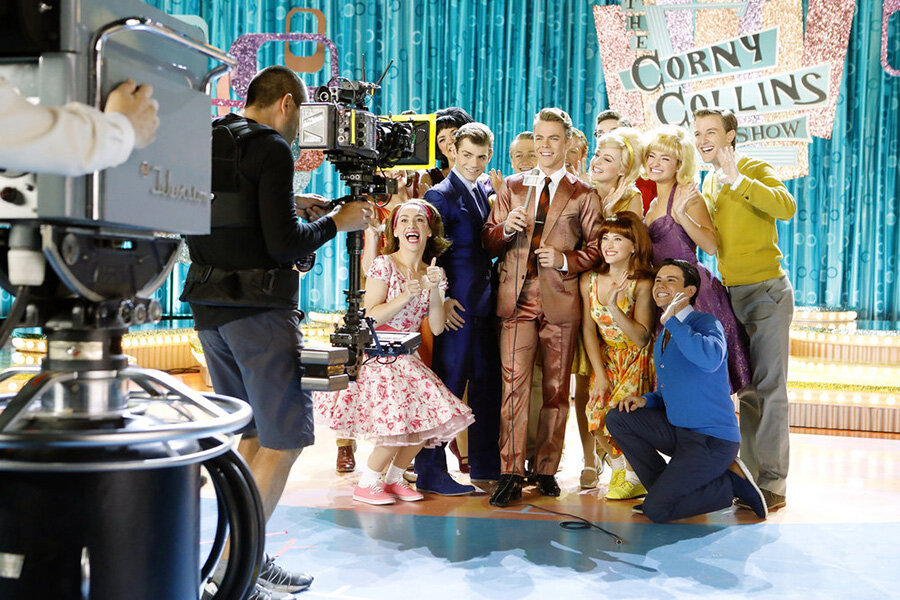NBC musicals return with 'Hairspray': Why do we still want live shows?
Loading...
You can’t stop the beat and you can’t stop NBC’s live musicals.
The network is continuing its tradition of debuting a live theatrical production in December with “Hairspray Live!,” which airs Dec. 7. It stars Maddie Baillio in the lead role of Tracy Turnblad, a teenager growing up in 1960s Baltimore who loves to dance. Harvey Fierstein, Martin Short, Ariana Grande, Jennifer Hudson, and Garrett Clayton co-star.
It’s the latest live musical to come to TV, as programming like the Super Bowl, the Oscars, live results shows like “The Voice,” and these NBC productions demonstrate that TV viewers today may love “binge-watching,” but some are still drawn by live television. The appeal, say observers, feeds on a blend of seasonal nostalgia, the attraction of programming billed as an "event," and having a shared, authentic and spontaneous experience with people across the country.
NBC kicked off the current live TV musical approach with “The Sound of Music Live!” in 2013 – its first live musical in almost 50 years, starring country superstar Carrie Underwood. The experiment paid off in a big way for NBC, drawing more than 18 million viewers that night.
Robert Thompson, director of the Bleier Center for Television and Popular Culture at Syracuse University, points to Ms. Underwood's participation as one reason for the musical's success.
“I think ‘The Sound of Music’ got the numbers it did because it was the first one of these things and because of who was starring in it,” Mr. Thompson says, calling Underwood a "big draw name."
Unsurprisingly, more shows quickly followed. NBC aired “Peter Pan Live!” in 2014 and “The Wiz Live!” in 2015; then Fox followed suit, bringing “Grease: Live” to TV earlier this year. Fox also aired “The Passion” and “The Rocky Horror Picture Show: Let's Do the Time Warp Again” earlier this year, but they lacked the inherent drama of a fully live performance.
None have yet beat “The Sound of Music” in the ratings. But the shows continue, and more recent ones, including “Grease,” have been viewed as wins in the ratings. "Grease: Live," for example, which beat all other NBC musicals besides "Music," brought in about 12 million viewers that night. That's less than what CBS's "The Big Bang Theory," for example, usually draws (the most recent episode brought in more than 14 million), but more than shows that are considered hits, such as "Grey's Anatomy" and "How to Get Away with Murder," both of which drew far few viewers than "Grease" when they last aired new episodes (about 8 million and 4 million, respectively).
But something more than the appeal of presently popular actors is behind the musicals' successes. Thompson points to the similar time period in which each musical has aired and the familiar subject matter.
“These are real classics,” he says of the shows chosen so far. “‘[The] Sound of Music,’ ‘The Wiz,’ ‘Peter Pan,’ ‘Grease’ – these are not exactly experimental musicals. These are big mainstream hits that already have been pre-sold by their position in the culture.”
That feeling of nostalgia and familiarity is intensified by their timing during the winter holidays, he says. “Some people are still reminded of the days when ‘The Wizard of Oz’ used to play every year at a certain time and ‘The Ten Commandments’ played every year.”
In many ways, expecting audiences to tune into a live show seems to go against everything we know about our current TV age, when viewers can watch a show when they want to watch it more than ever before. The DVR has long been a staple of TV watching, and the last several years have seen the rise of Netflix, which usually debuts an entire season of a TV show on one day, to be watched at a viewer’s leisure. Other streaming options, too, have helped give rise to “binge-watching,” a habit of many TV fans who watch as many episodes as they want in one sitting rather than tuning in weekly.
So why are viewers tuning in to these live musicals in large enough numbers that networks continue to greenlight them? Why are they watching live programs, such as “The Voice” and “Dancing With the Stars” (two of TV’s highest-rated shows) or the Super Bowl, which regularly ranks as the most-watched TV show of the year?
Paul Levinson, professor of communication and media studies at Fordham University and author of "The Plot to Save Socrates," points out that sports programming continues to be incredibly popular, as does live broadcast news. And live theater was there in TV's early days, with programs like “Playhouse 90,” which depicted live dramas.
“Obviously there's a big difference between sports and news and musicals and ‘Playhouse 90,’ but they all feed on the same thing, which is the just inherent excitement of watching something that's happening as you're watching it,” Professor Levinson says.
Thompson says that now the desire to watch something live merely exists alongside our desire to binge-watch – it’s not replaced by it.
“For the most part, we want to watch what we want to watch, when we want to watch it, where we want to watch it,” he says. “…But even though most of the time, we want to have that total control of programming our own stuff at our own time, there is, I think, always an appeal that occasionally, we do like that idea of having a communal experience.”






